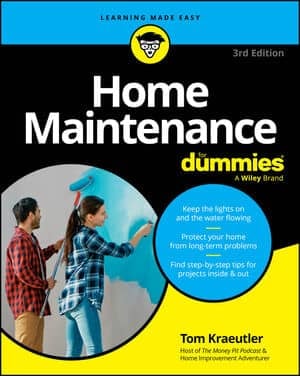Take the intimidation out of common home repair jobs
Home Maintenance For Dummies gives you the know-how you need to inspect, tune up, and make repairs to every room of your house. Learn how to stop drafty windows and doors, fix roof leaks, unclog pipes, silence squeaky floors, test your water pressure, fix a dripping faucet, and beyond. Plus, learn tricks of the trade to stop wasting energy, lower energy bills, and improve the comfort of your home. Some home maintenance jobs are easy to ignore, but you'll save thousands in repair costs if you keep things running properly. And when things do break, you can save even more money with DIY repairs. You'll be amazed how easy it is to do many common upkeep tasks yourself. With step-by-step guides, detailed diagrams, and instructions for every room of the home, you'll finally be able to fix those little problems that have been nagging at you. This updated edition covers the latest heating and cooling systems, tankless water heaters, LED lighting, solar power, and all the other newfangled stuff in your house.
- Learn how to conduct routine inspections, keep major appliances running efficiently, and avoid costly mistakes
- Make a list for the must-have tools in your toolbox
- Recognize the difference between an easy DIY repair and something an expert should handle
- Protect your home from long-term problems and secure the value of your asset
First-time homeowners looking for a guide to keep their dream home in tip-top shape, as well as homeowners who aren't familiar with common home repairs, will love this beginner-friendly Dummies guide.
Take the intimidation out of common home repair jobs
Home Maintenance For Dummies gives you the know-how you need to inspect, tune up, and make repairs to every room of your house. Learn how to stop drafty windows and doors, fix roof leaks, unclog pipes, silence squeaky floors, test your water pressure, fix a dripping faucet, and beyond. Plus, learn tricks of the trade to stop wasting energy, lower energy bills, and improve the comfort of your home. Some home maintenance jobs are easy to ignore, but you'll save thousands in repair costs if you keep things running properly. And when things do break, you can save even more money with DIY repairs. You'll be amazed how easy it is to do many common upkeep tasks yourself. With step-by-step guides, detailed diagrams, and instructions for every room of the home,
- Learn how to conduct routine inspections, keep major appliances running efficiently, and avoid costly mistakes
- Make a list for the must-have tools in your toolbox
- Recognize the difference between an easy DIY repair and something an expert should handle
- Protect your home from long-term problems and secure the value of your asset
First-time homeowners looking for a guide to keep their dream home in tip-top shape, as well as homeowners who aren't familiar with common home repairs, will love this beginner-friendly Dummies guide.

